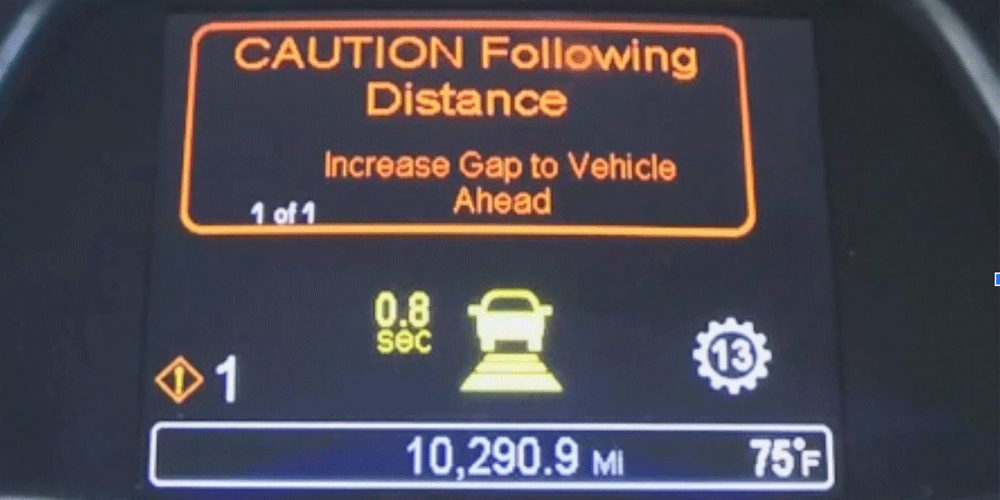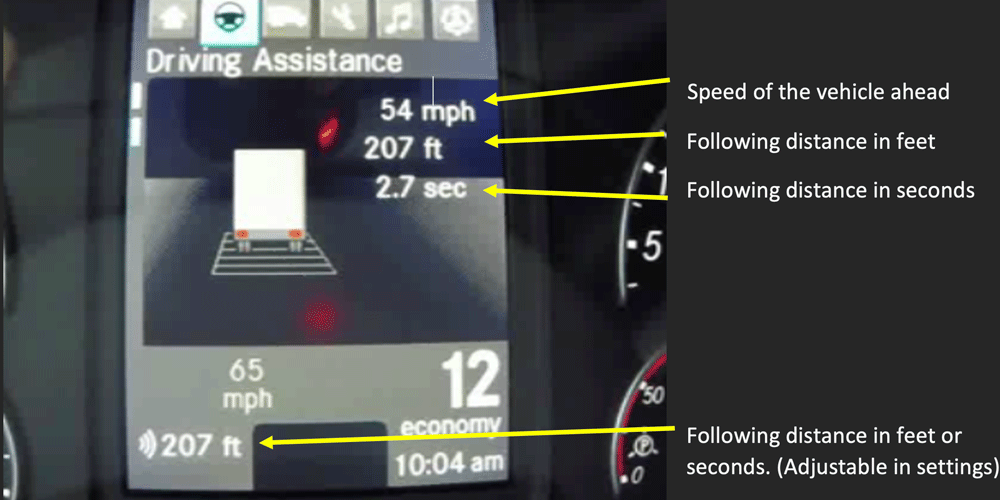What is Adaptive Cruise for Semi-Trucks? [+ How to Use It]
Michael Carlson is a safety manager with ATS. He assists drivers, as well as the operations team, adhere to safety protocols. Before coming to ATS, he had years of hands-on safety experience. He worked for the railroad for a while before starting a career driving, where he hauled hazmat freight for eight years. Michael loves working for safety at ATS because he believes in the program. ATS has a great safety team and it takes each and every person to make the roads and the company safer.
Did you know one of the biggest causes of rear-end collisions involving semi-trucks is due to close following distance? Did you know there’s a way that you can prevent this?
Maintaining a safe following distance — eight seconds as recommended by the Department of Transportation (DOT) — is key to helping avoid these damaging accidents.
One of the ways you can make maintaining a safe following distance easier? Adaptive cruise control. It automatically adjusts your following distance based on the speed of traffic around you.
As a former truck driver myself and now a member of the safety team at Anderson Trucking Service, I know just how beneficial this technology is.
In this article, I’ll explain what adaptive cruise is, how to use it and its pros and cons. If you’re a driver who’s never used this technology before, you’ll have a great understanding of its advantages and you’ll be well-equipped to use it.
What is Adaptive Cruise Control?
Adaptive cruise control (ACC), also known as dynamic cruise control, is a computer software that monitors following distance and automatically adjusts vehicle speed to maintain a set following distance. It uses the accelerator, engine brakes, compression brakes and foundation brakes to speed up and slow down the vehicle to keep the distance between you and the vehicle ahead of you.
A laser or radar-based sensor system is key to the system’s functionality. Sensors detect the distance of the vehicle ahead and then adjust accordingly when that distance begins narrowing.
ACC works in conjunction with accident mitigation equipment. It doesn’t work with any sort of fleet dash cam, however, like the Lytx camera technology that ATS uses.
Just like you’d turn cruise control on and off, you can turn off ACC. Some drivers love the technology and others don’t like it. A lot of drivers, however, probably haven’t used it yet.
While the technology was invented in 1990 and patented in 1991, it hasn’t been in semi-trucks that entire time. In fact, the technology has only been implemented in semi-trucks in the last few years. However, just because you have a new truck, doesn’t mean it’ll be included. It’s an additional safety feature that isn’t included with every truck.
How to Use Adaptive Cruise Control
Every ACC system is different depending on the engine type and the original equipment manufacturer (OEM). The layout will display differently on each system, as will the way you set your distance. Some systems will show your following distance in feet and some will show it in seconds.
Your user manual will include instructions and it’s easy to search your make and model on Google or YouTube and find a comprehensive explanation of how to use the system in your truck. You can also talk to your shop for help. If you’re an ATS driver, don’t hesitate to talk to the shop or call the safety team.
You can set your following distance on your own, but the systems won’t let you set your following distance lower than three seconds. Each system has its own set minimum, but it won’t go below that.

Pros and Cons of Adaptive Cruise Control
Like any technology, there are pros and cons to using it.
Let’s start with the pros of using adaptive cruise control as a truck driver.
Pros of Adaptive Cruise Control
ACC takes the guesswork out of following distance. A lot of drivers struggle to train their eyes to see what a safe following distance is. They constantly have to monitor and count to measure their distance from other vehicles. With ACC, that guesswork is eliminated.
ACC shines in stop-and-go traffic. A lot of drivers get upset about being cut off, especially in busy traffic. ACC helps mitigate some of that frustration because ACC uses your accelerator and brakes to speed up and slow down for you.
Any tool we can use to help increase and maintain a safe following distance is a great tool. Because it works with the accident mitigation system, it will brake for you if you’re about to hit another vehicle. Again, following too close is the primary cause of rear-end collisions, which can do serious damage. Using ACC can help decrease the occurrence of those accidents.
Even though ACC is fairly new equipment on semi-trucks, the system has helped prevent countless accidents.
Cons of Adaptive Cruise Control
Utilizing ACC can feel a little like taking the power out of your hands. When you’re constantly monitoring following distance with your eyes and mind, you’re training yourself and building that skill. When you rely solely on ACC, you’re letting that muscle weaken. If you can’t use your ACC for some reason (more on that below), you’ll have to get used to using that following-distance muscle again.
Some use ACC as an excuse to let the truck “drive for them.” It should be noted that ACC is just a tool and the role of the driver isn’t diminished; the driver is still the most important safety feature in the vehicle.
Just like you shouldn’t use cruise control when it’s raining, snowing or excessively windy, you also shouldn’t use ACC. Using cruise control during certain weather conditions can be dangerous.
Additionally, if the radar is blocked on the grill of your truck with slush or snow, it won’t work properly. As we all know, technology isn’t perfect, so there are other times when the technology simply might not work. The radar could be off, meaning the following distance will be off. Occasionally the radar may need to be calibrated and adjusted.
Some drivers are confused about how ACC works with accident mitigation equipment and camera systems. They think that ACC will prevent them from getting violations (or points, if your carrier is using the camera as a safety coaching tool) with their camera system. However, ACC doesn’t work with camera systems. If you get an alert from your camera system, it means you’ve already violated following distance rules.
If you’ve never used ACC, it can be confusing to set it up for the first time. On some systems, it’s all digital. You may have toggle through a lot of settings to get to the ACC settings. It’s not always user-friendly, especially if you’re not a tech-savvy person.

Practicing Accident Prevention
Understanding and practicing safe following distance is crucial in preventing rear-end collisions involving semi-trucks. ACC utilizes sensors to monitor the distance to the vehicle ahead and adjusts speed accordingly, making it particularly valuable in situations like stop-and-go traffic. This technology, integrated with accident mitigation systems, plays a significant role in preventing collisions by applying brakes if necessary.
While ACC offers numerous advantages, there are also drawbacks to consider. Overreliance on the technology can lead to diminished driver skills in judging and maintaining following distance manually.
Additionally, ACC shouldn’t be used in adverse weather conditions or when the radar system is obstructed. ACC doesn't replace your role and responsibility in safe driving. While ACC is great, you’re the most important safety feature in the truck. You still must pay close attention while you drive and avoid distractions.
Incorporating ACC into your driving routine may require familiarizing yourself with its setup, especially if the system's interface is complex. Overall, by understanding the benefits and limitations of adaptive cruise control, drivers can make informed decisions about its use, enhancing road safety and contributing to a reduction in rear-end collisions involving semi-trucks.
You can also prevent accidents by following these tips.
![What is Adaptive Cruise for Semi-Trucks? [+ How to Use It]](https://blog.drive4ats.com/hubfs/Images/Blog/ACC/TwoHandsOnWheelFeatured.png)
